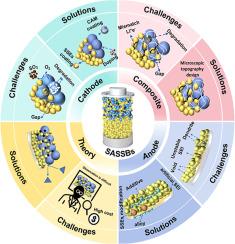Interface Compatibility in Sulfide-Based All-Solid-State Batteries: Challenges and Strategies at the Electrode–Electrolyte Interfaces
IF 20.2
1区 材料科学
Q1 CHEMISTRY, PHYSICAL
引用次数: 0
Abstract
Sulfide-based all-solid-state batteries (SASSBs) are compelling candidates for next-generation energy storage due to their high ionic conductivity and compatibility with lithium metal. Nevertheless, the poor chemical and mechanical compatibility at electrode–electrolyte interfaces remains a central obstacle to practical implementation. This review focuses exclusively on interfacial compatibility challenges and solutions for both the anode–electrolyte(AEI) and cathode–electrolyte interfaces(CEI) in sulfide-based solid electrolytes systems. We delineate the principal mechanisms of interfacial instability, including physical debonding, chemomechanical degradation, and lithium dendrite nucleation and propagation. We, then systematically assess recent strategies such as artificial solid electrolyte interphase (SEI) engineering, interlayer design, in-situ interphase formation, cathode surface coatings, and composite interface architectures. Furthermore, we integrate results from advanced characterization techniques and multiscale simulations to clarify the interfacial processes that control performance. Finally, we propose future research directions aimed at interfacial stability, manufacturability, and multi-layer integration. In summary, this review offers a solution oriented roadmap for engineering robust interfaces in commercially relevant SASSBs.

硫化物基全固态电池的界面兼容性:电极-电解质界面的挑战和策略
硫化物基全固态电池(sassb)因其高离子电导率和与锂金属的相容性而成为下一代储能系统的有力候选者。然而,电极-电解质界面的化学和机械相容性差仍然是实际实施的主要障碍。本文主要综述了硫化物基固体电解质体系中阳极-电解质(AEI)和阴极-电解质界面(CEI)的界面相容性挑战和解决方案。我们描述了界面不稳定性的主要机制,包括物理脱键、化学机械降解和锂枝晶的成核和扩展。然后,我们系统地评估了最近的策略,如人工固体电解质界面(SEI)工程、层间设计、原位界面形成、阴极表面涂层和复合界面结构。此外,我们整合了来自先进表征技术和多尺度模拟的结果,以阐明控制性能的界面过程。最后,针对界面稳定性、可制造性和多层集成提出了未来的研究方向。总之,这篇综述为在商业相关的sassb中设计健壮的接口提供了一个面向解决方案的路线图。
本文章由计算机程序翻译,如有差异,请以英文原文为准。
求助全文
约1分钟内获得全文
求助全文
来源期刊

Energy Storage Materials
Materials Science-General Materials Science
CiteScore
33.00
自引率
5.90%
发文量
652
审稿时长
27 days
期刊介绍:
Energy Storage Materials is a global interdisciplinary journal dedicated to sharing scientific and technological advancements in materials and devices for advanced energy storage and related energy conversion, such as in metal-O2 batteries. The journal features comprehensive research articles, including full papers and short communications, as well as authoritative feature articles and reviews by leading experts in the field.
Energy Storage Materials covers a wide range of topics, including the synthesis, fabrication, structure, properties, performance, and technological applications of energy storage materials. Additionally, the journal explores strategies, policies, and developments in the field of energy storage materials and devices for sustainable energy.
Published papers are selected based on their scientific and technological significance, their ability to provide valuable new knowledge, and their relevance to the international research community.
 求助内容:
求助内容: 应助结果提醒方式:
应助结果提醒方式:


